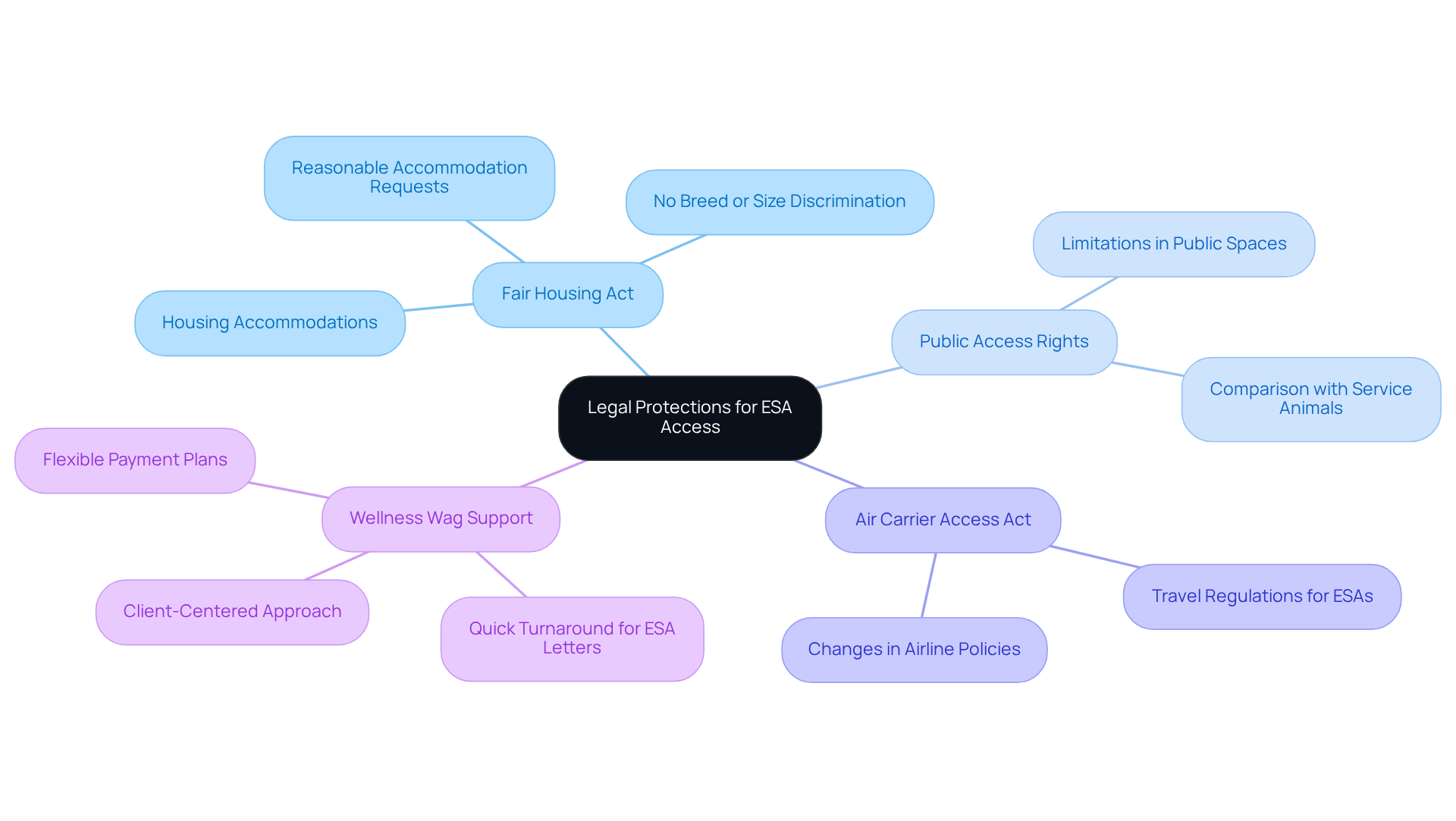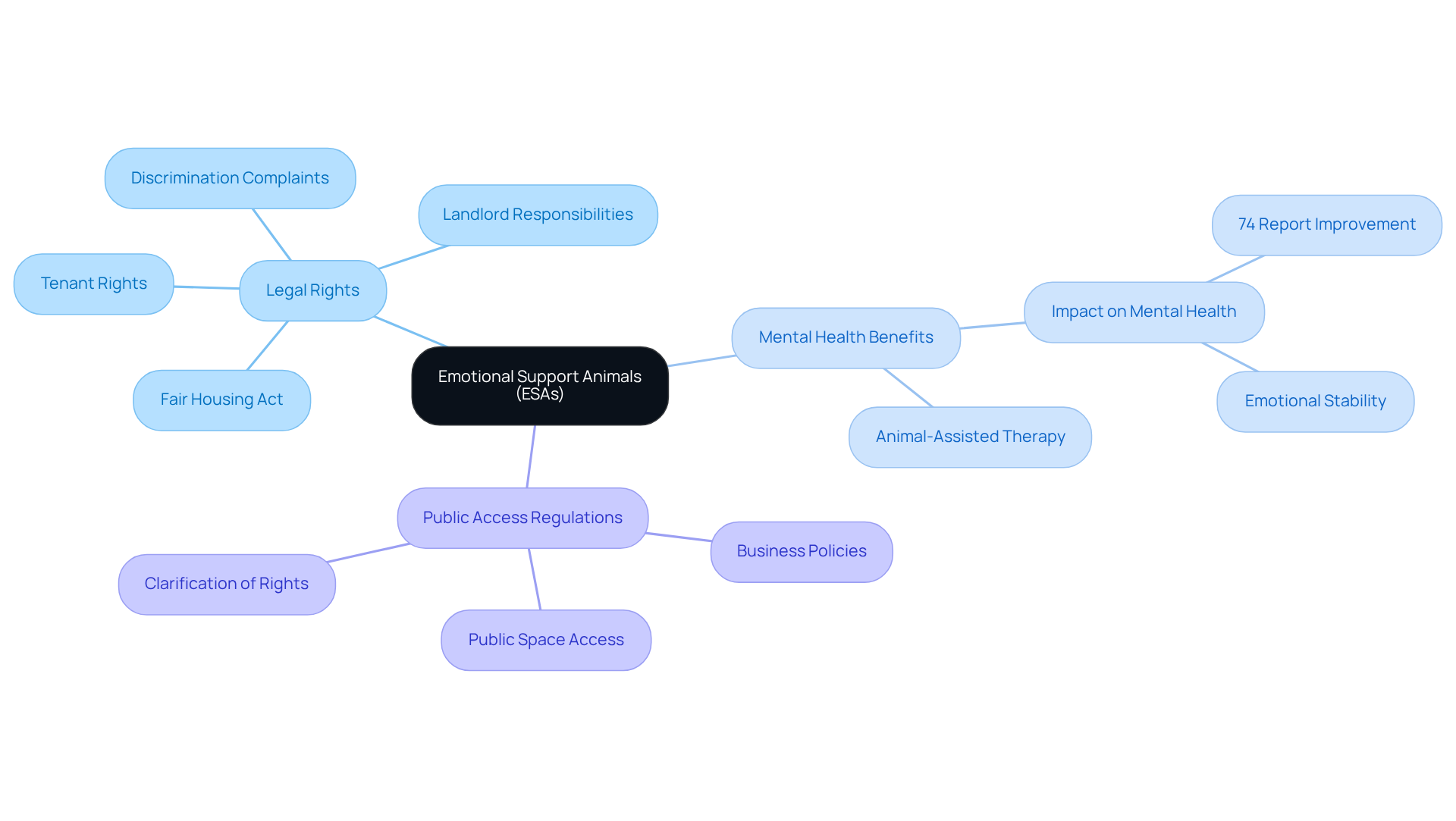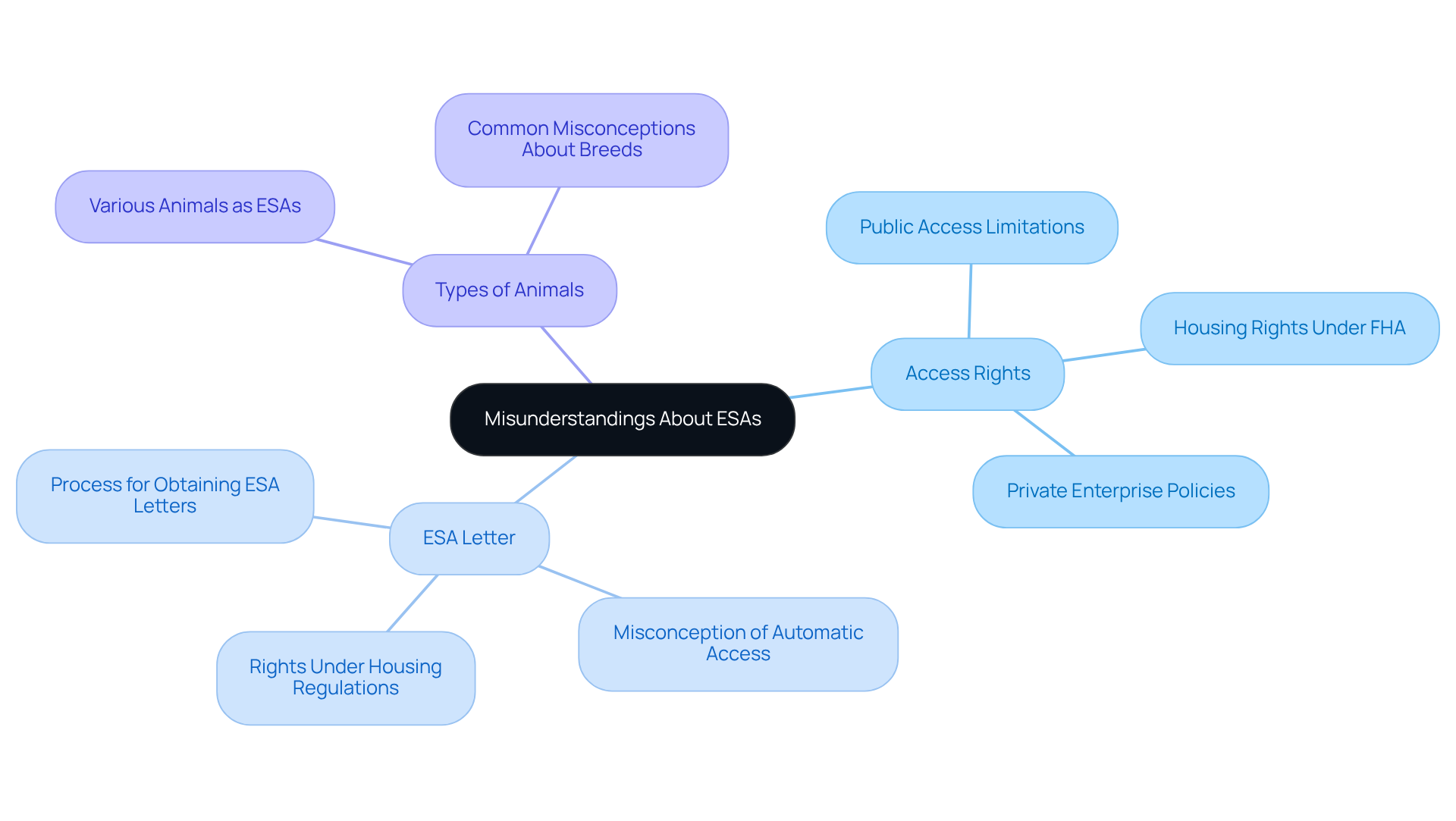

Where Can ESA Dogs Go? Understanding Their Access Rights
by Lena Park
Last updated: August 4, 2025
Verified and Approved by:
Angela Morris,
MSW, LCSW
Fact Checked

Overview
The places where ESA dogs can accompany their owners are primarily governed by legal protections under the Fair Housing Act. This law grants them access to residential settings, yet it’s important to note that they do not possess the same public access rights as service animals under the Americans with Disabilities Act. Understanding these distinctions is crucial for ESA owners, as they must seek permission from private establishments for public access. This highlights the necessity of having valid documentation to avoid potential penalties for misrepresentation. By recognizing these challenges, we can better appreciate the support that ESA letters provide, helping individuals navigate these complexities with confidence and care.
Introduction
Understanding the access rights of Emotional Support Animals (ESAs) is crucial for those navigating the complexities of mental health support. These beloved companions offer essential emotional assistance, yet their rights in public spaces differ significantly from those of trained service animals.
Many individuals face confusion regarding where ESA dogs are permitted, which can heighten feelings of frustration and isolation. This raises an important question: what are the actual legal protections for these animals, and how can owners advocate effectively for their access rights?
By exploring these topics, we can illuminate the vital role ESAs play in enhancing emotional well-being while also clarifying their limitations in public settings. Together, we can find pathways to ensure that the support these animals provide is recognized and respected.
Define Emotional Support Animals and Their Role
Emotional Support Animals (ESAs) are beloved pets that provide comfort and assistance to individuals navigating emotional or psychological challenges. Unlike trained support animals that perform specific tasks for those with disabilities, ESAs do not require specialized training. Their primary role is to offer companionship, alleviating feelings of anxiety, depression, and loneliness, while enhancing the emotional well-being of their owners. While any pet can serve as an ESA, dogs and cats are the most common choices. The bond between an ESA and its owner can profoundly elevate the quality of life, making these animals vital for those who depend on them for emotional support.
Have you ever felt overwhelmed by your emotions? The struggles associated with mental health can often feel isolating. However, the presence of an ESA can bring light into the darkest moments, offering a sense of purpose and connection. These furry companions not only provide love but also help ease the burdens of daily life. Imagine coming home to a wagging tail or a gentle purr—these simple joys can make a world of difference.
Emotional Support Animals are more than just pets; they are lifelines for many. Their unwavering companionship can significantly improve emotional health, fostering a sense of belonging and security. If you or someone you know is grappling with emotional challenges, consider the profound impact an ESA could have. With the right support, including an ESA letter, you can unlock the many benefits these animals offer. Remember, you are not alone on this journey. Support is available, and your emotional well-being matters.
Explore Legal Protections for ESA Access
The Fair Housing Act (FHA) provides essential protections for individuals with emotional support animals, allowing them to share their homes with these beloved companions in places that typically restrict pets. This important legislation mandates that landlords offer reasonable accommodations for tenants with emotional support animals once their housing applications are approved. It is vital to ensure that individuals are not discriminated against because of their mental health conditions.
However, it is also important to understand where can ESA dogs go, since emotional support animals do not have the same public access rights as service animals under the Americans with Disabilities Act (ADA). Consequently, while emotional support animals are welcomed in their guardians’ homes, it is important to know where can ESA dogs go in public spaces such as restaurants, shops, or public transit without prior permission from the establishment. Misrepresenting an emotional support animal can result in penalties, underscoring the necessity of having valid documentation. Understanding these legal distinctions is crucial for individuals with emotional support animals, empowering them to advocate for their rights and navigate housing situations effectively.
Wellness Wag has supported over 50,000 patients, reinforcing its credibility in providing legitimate ESA letters. Additionally, the Air Carrier Access Act (ACAA) specifies regulations regarding where can ESA dogs go, which is particularly relevant for owners contemplating travel options. Lastly, Wellness Wag offers flexible payment plans, ensuring that their services remain accessible to a wider audience, providing the support that many need during challenging times.

Identify Locations Where ESAs Are Allowed
Emotional Support Animals (ESAs) play a crucial role in residential settings, as protected by the Fair Housing Act. This legislation ensures that tenants can share their lives with support animals in apartments, condominiums, and houses, regardless of existing no-pet policies. Such legal protections are essential for individuals grappling with mental health challenges, as they help maintain the vital therapeutic bond with their beloved pets. In fact, studies reveal that 74% of pet owners experience improved mental health due to their animals, underscoring the profound impact of ESAs on emotional well-being.
Furthermore, many educational institutions, including college residences, are required to accommodate students with emotional support animals. This recognition acknowledges the significant role these animals play in enhancing mental health. However, the regulations regarding where can ESA dogs go in public spaces are less clear-cut. While some businesses may choose to welcome emotional support animals, they are not legally obligated to do so. Therefore, it is advisable for ESA owners to reach out to establishments in advance to clarify where can ESA dogs go and understand their policies regarding these cherished companions. This proactive approach not only helps avoid misunderstandings but also paves the way for a more seamless experience in public settings.
As R. Kaysen aptly stated, “If the Commission finds that the board discriminated against the resident, the building may be fined up to $250,000, not including damages awarded to the resident.” This statement highlights the serious legal implications surrounding ESA accommodations and the importance of being informed about one’s rights. Ultimately, understanding the legal rights associated with emotional support animals is vital for both tenants and students. It empowers them to advocate for their needs while enjoying the emotional benefits these pets provide.

Clarify Misunderstandings About ESAs
Misunderstandings about where can ESA dogs go can create significant confusion regarding their access rights. Many individuals may feel overwhelmed by the belief that emotional support creatures enjoy the same access rights as service animals. In reality, where can ESA dogs go in public areas such as restaurants, shops, or public transit is not guaranteed. Unlike assistance animals, which are trained to perform specific tasks for individuals with disabilities, emotional support beings primarily serve as companions and do not require specialized training or certification. As Scott Haiduc observes, “Emotional support creatures, or emotional support animals, are not regarded as service animals.” This common misconception can lead to feelings of frustration and uncertainty for ESA owners.
Another misconception is that possessing an ESA letter automatically grants access to any location. This belief can be misleading; while ESA holders do have rights under housing regulations, they must also understand where can ESA dogs go in relation to the policies of private enterprises concerning emotional support animals. For instance, only service animals are legally allowed in public areas, while emotional support animals are primarily protected by the Fair Housing Act, which permits reasonable accommodations in housing situations. Additionally, the Air Carrier Access Act provides specific protections for ESA owners when traveling, offering a sense of security for those who rely on their emotional companions.
Data suggests that around 18% of pet owners in the U.S. possess emotional support animals, reflecting a growing awareness of their mental health benefits. It’s important to recognize that approximately 31% of adults in the U.S. encounter an anxiety disorder at some point, highlighting the context in which emotional support animals are utilized. However, many individuals still struggle to understand the legal distinctions between emotional support creatures and service animals. Mental health professionals emphasize the importance of grasping these differences to effectively advocate for ESA rights. By dispelling these myths, ESA owners can navigate their rights and responsibilities more effectively, fostering a supportive environment for their emotional companions. Furthermore, it is essential to acknowledge that various types of animals can serve as ESAs, not just dogs or cats, thus broadening the scope of potential emotional support.

Conclusion
Emotional Support Animals (ESAs) hold a unique and vital place in the lives of many individuals, offering companionship and emotional stability during challenging times. While they play a crucial role in enhancing mental well-being, it is essential to recognize the specific access rights they possess. Unlike service animals, ESAs do not enjoy the same public access privileges, which can lead to confusion and misunderstandings regarding where they are allowed.
Many individuals face emotional challenges that can feel overwhelming. The presence of an ESA can provide comfort and support, helping to alleviate feelings of loneliness and anxiety. However, misconceptions about ESA access can create obstacles that hinder the support these individuals need. It’s important for ESA owners to understand their rights and the limitations that accompany them. Being informed empowers individuals to advocate for their needs effectively.
Understanding the rights and responsibilities associated with Emotional Support Animals is crucial for both owners and the general public. By fostering awareness and dispelling myths, we can create a more supportive environment for those who rely on these cherished companions. Have you ever felt uncertain about where your ESA is allowed? It is imperative to stay informed about ESA access rights, particularly as regulations may evolve. Advocating for clearer policies and supporting mental health initiatives can help ensure that individuals and their emotional support animals receive the recognition and accommodations they deserve.
Ultimately, the journey with an ESA is one of connection and support. By acknowledging the emotional struggles faced by many and promoting understanding, we can build a community that embraces the healing power of these beloved companions.
Frequently Asked Questions
What are Emotional Support Animals (ESAs)?
Emotional Support Animals (ESAs) are beloved pets that provide comfort and assistance to individuals facing emotional or psychological challenges. They offer companionship to alleviate feelings of anxiety, depression, and loneliness, enhancing the emotional well-being of their owners.
How do ESAs differ from trained support animals?
Unlike trained support animals that perform specific tasks for individuals with disabilities, ESAs do not require specialized training. Their primary role is to provide companionship and emotional support.
What types of animals can serve as ESAs?
While any pet can serve as an ESA, dogs and cats are the most common choices.
How can an ESA improve a person’s quality of life?
The bond between an ESA and its owner can profoundly elevate the quality of life by providing love and companionship, helping to ease the burdens of daily life, and fostering a sense of belonging and security.
What should someone do if they are considering getting an ESA?
If you or someone you know is grappling with emotional challenges, consider the potential impact an ESA could have. Obtaining an ESA letter can help unlock the benefits these animals offer.
What emotional benefits do ESAs provide?
ESAs can significantly improve emotional health by offering unwavering companionship, which can help individuals feel less isolated and more supported in their journey through emotional challenges.
Certify Your Emotional Support Animal Today

Why You Can Rely on Us?
At Wellness Wag, we believe your pet deserves care rooted in both science and compassion. Each article is carefully researched, written in clear language for pet owners, and then reviewed by qualified professionals to ensure the information is evidence-based, current, and practical for real-life care. Our goal is to help you feel confident in making informed decisions about your pet’s health and well-being.
Reviewed by
Angela Morris, MSW, LCSW
Angela is a licensed clinical social worker with 20 years of experience in patient advocacy and community mental health. She has assisted numerous clients with ESA evaluations and brings a deep understanding of disability accommodations, ensuring that all information is accurate, supportive, and practical.

Written by :
Lena Park
Last Updated :
August 4, 2025












